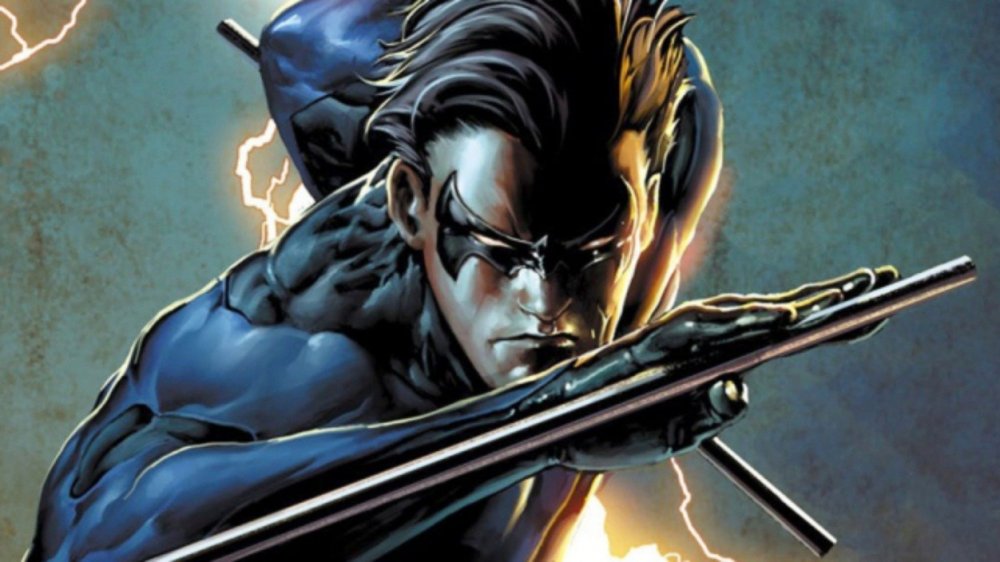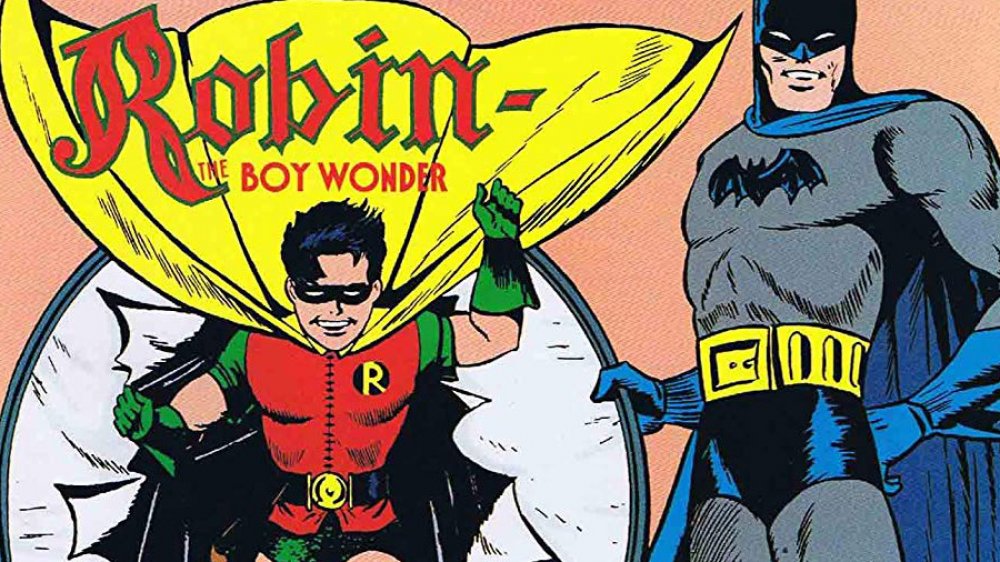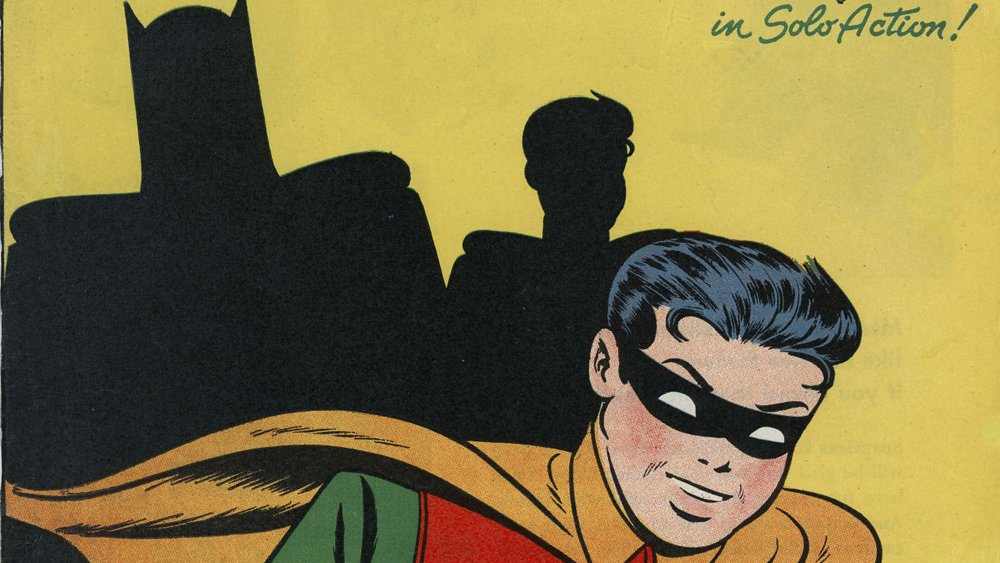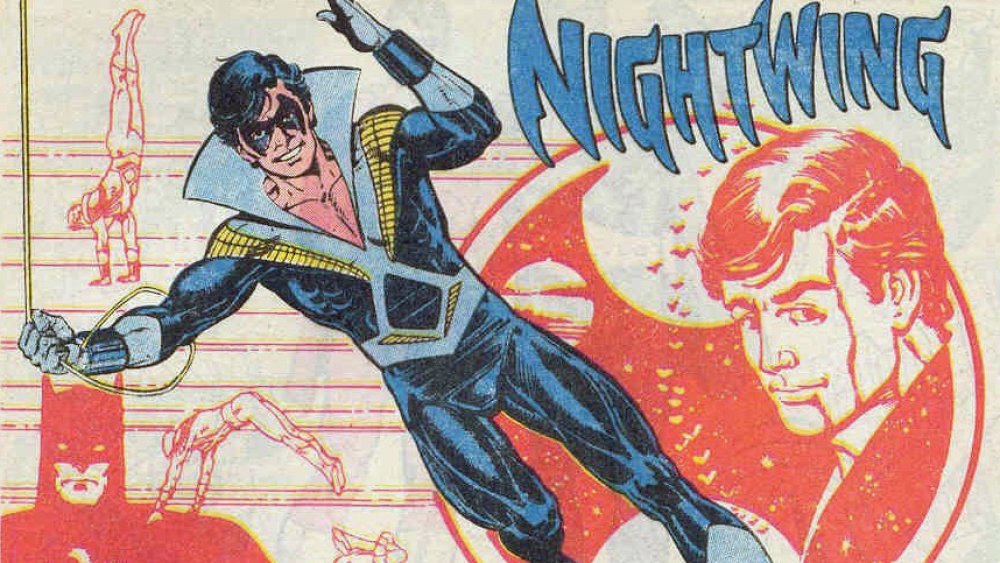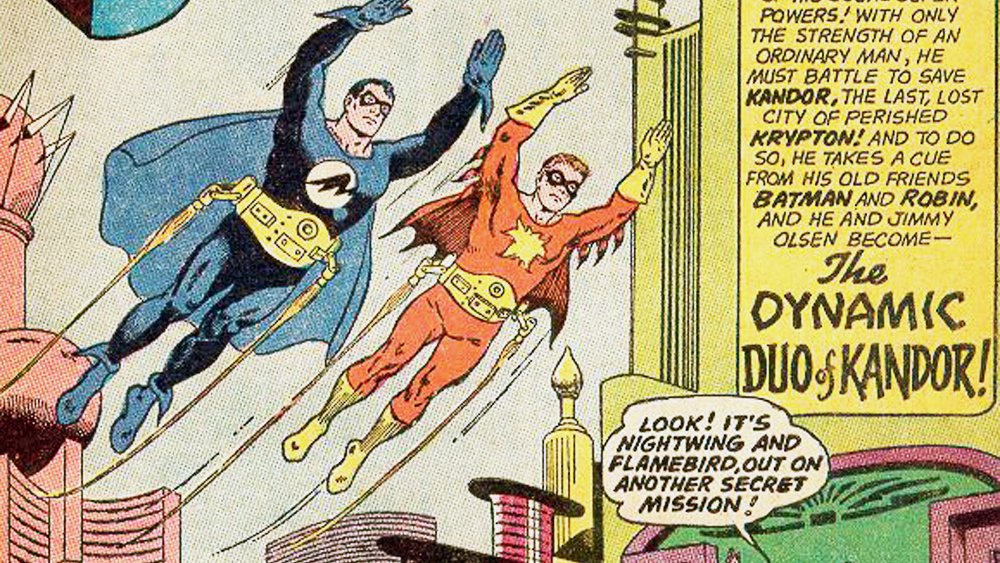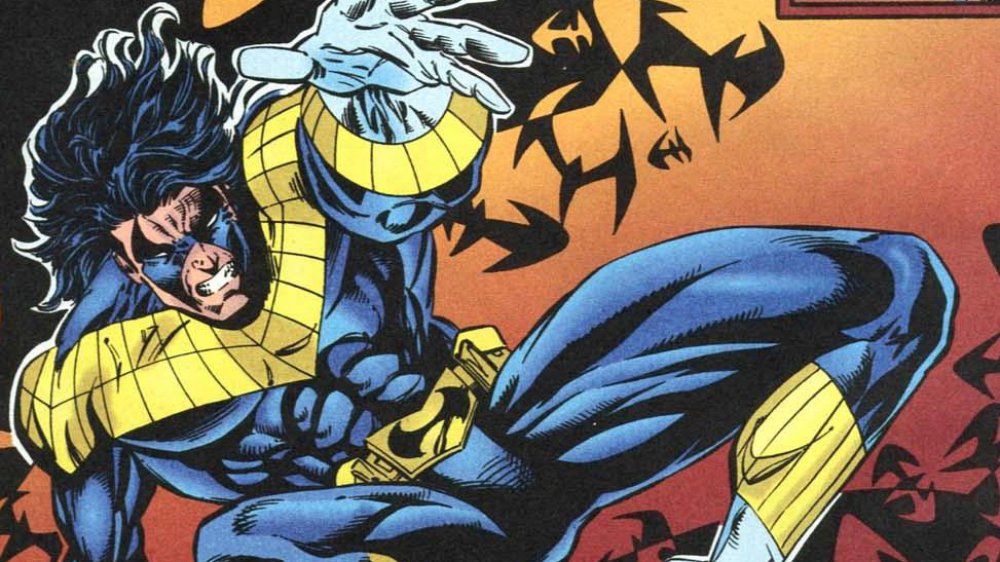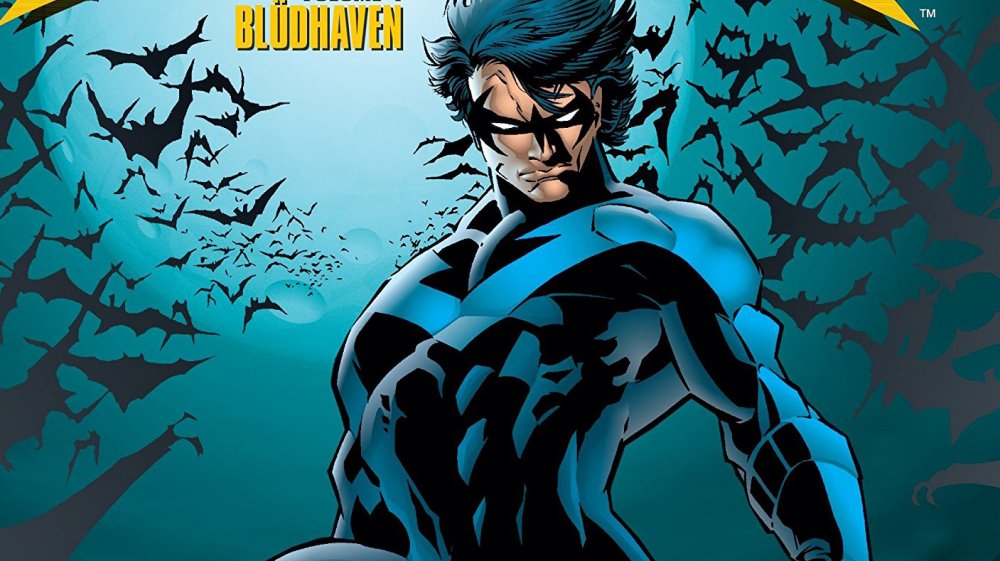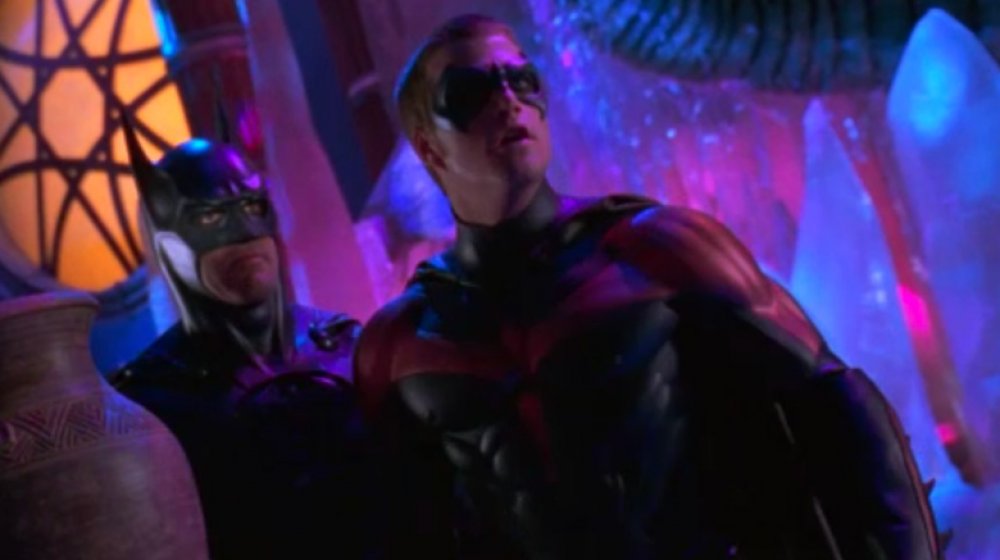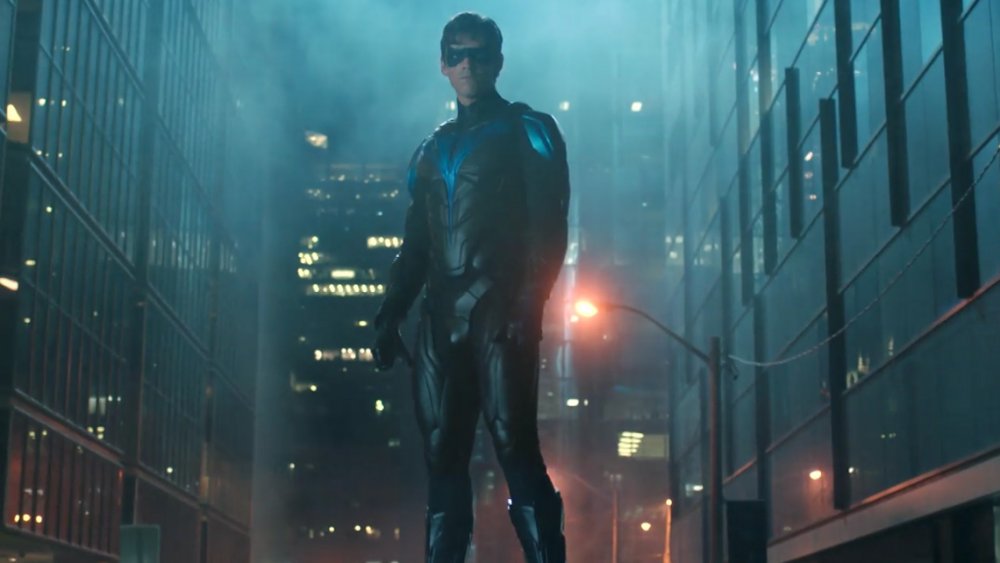The Untold Truth Of Nightwing
Dick Grayson has been around in the pages of Batman comics almost as long as the Dark Knight himself, and when you get right down to it, he's changed a whole lot more over the course of those 80 years than almost any other superhero. Now, as the second season of DC Universe's Titans show comes to an end, the biggest and most enduring of those changes is going to be brought to live action for the first time, as Dick sheds the identity of Robin and re-emerges as his own hero: Nightwing.
So how did we get here? How did Dick succeed at making the transition from sidekick to full-fledged hero when so many other characters failed, even though he was fighting his way out from under one of the biggest shadows in superhero history? The answer goes all the way back to the beginning of a character who put the "dynamic" in the Dynamic Duo. From the way that he redefined comics in the Golden Age to the heroic haircut that he finally ditched in the '90s, here's the truth behind the evolution of Nightwing.
The sensational character find
Nightwing's origins — both in continuity and in real life — start all the way back at the dawn of the Golden Age of Comics and the explosion of new superheroes that hit the page after Superman debuted in 1938 and became a ridiculously profitable hit. Some of them attempted to follow directly in Jerry Siegel and Joe Shuster's footsteps with their own super-powered creations, with varying degrees of success, but the most prominent among them did things a little differently. Rather than trying to shoulder into the tight field of costumed superhumans — look up Stardust the Super Wizard sometime if you want to see how weird that side of things was getting — Bill Finger brought unemployed artist Bob Kane the idea of a costumed hero without superpowers who was a little bit darker than the others.
The character was called Batman. You've probably heard of him. The thing is, the Batman who debuted in 1940 wasn't quite the pop culture icon that he'd become. Instead, the first few Batman stories are really just ripping off the Shadow, a popular pulp novel and radio character, but with pointy ears and a bat-winged cape instead of a slouch hat and a trenchcoat. Over the next few months, Finger, Kane, and artist Jerry Robinson would refine their character. If you need an example of how long it took them to figure things out, consider that Batman didn't even have an origin story until Detective Comics #33, a full six months after Batman made his first appearance.
It was in Detective Comics #38, however, that they gave Batman what NPR commentator and Bat-historian Glen Weldon, author of The Caped Crusade, considers to be the final ingredient for making Batman the character we can still recognize today. On a cover that announced him as "The Sensational Character Find of 1940" — which, in retrospect, is maybe the most accurate a comic book cover blurb has ever been — Robin was introduced to the world.
The Boy Wonder
Robin's importance to the Golden Age cannot be overstated. In a lot of respects, he's second only to Superman, and possibly Wonder Woman, in how influential he was on the first generation of superhero comics, eclipsing even Batman. The reason, as Weldon put it, is that Batman and Robin "would soon become shorthand for the very concept of a two-person team."
Sidekicks had existed before Robin, of course — it's a lineage that goes back through Dr. John Watson, Sancho Panza, and, if you want to get Biblical about it, Moses's brother Aaron, and even in comics, the Crimson Avenger's pal Wing arrived first by a couple of years. Robin, however, redefined the role, particularly in the burgeoning genre of superheroes. For one thing, Dick Grayson, circus acrobat turned boy vigilante, was wildly popular, and it's easy to see why. The kids who already loved Batman were stoked about a character who was a kid who got to hang out with Batman and be his best friend, which, all things considered, was a much more pleasant power fantasy than Batman himself, who watched his parents die in an alley.
Before long, the sidekick population exploded in the same way that superheroes had boomed after Superman. Marvel's original Human Torch teamed up with Toro a few months after Robin, giving readers the dubious image of a man on fire being accompanied into battle by a child who was also on fire. By the time Captain America debuted alongside Bucky Barnes in 1941, a kid sidekick was virtually mandatory for the genre. The one big exception was Superman; Jimmy Olsen would be imported from the radio show by 1941, but wouldn't really become Superman's Pal for another few years. Robin's influence was there, though: rather than going with the sidekick angle, Siegel and Shuster went after the idea of a younger character for kids to identify with by introducing Superboy — not a sidekick, just Superman when he was... well, you've probably figured this one out, right?
Going Solo
While he'd always be best known as the back half of "Batman And," it was clear from the beginning that Robin was every bit as popular as his mentor. For proof, just look at the comics: it's nearly impossible to find a Batman story in the '40s or '50s where he wasn't hanging out with the Boy Wonder, but Robin had plenty of solo stories, even headlining Star-Spangled Comics for five years before superheroes in general fell out of popularity. That means that if you do the math, Robin had more appearances in the Golden Age than Batman did.
Clearly, Dick Grayson was a viable solo character in his own right, and while he never got his own series, he was featured in solo stories in books like Detective Comics and Batman Family. By the early '80s, he was even the star of DC's hottest book, The New Teen Titans, a revival of a series where a bunch of kid sidekicks were thrown together for wacky adventures that had been reimagined by Marv Wolfman and George Perez as an X-Men-esque superhero soap opera.
Finally, someone thought to ask the question that had been hanging over Grayson's head for at least a couple of decades by that point. We know that Batman and Robin are inextricably tied to each other, and that one character completes the other, so the role of Robin is always going to be Batman's sidekick. If that's the case, though, If Dick Grayson can work just as well on his own, then does he need to be Robin? The answer, it turned out, was no, but that also led to another question: what's he going to be now?
The first Nightwing
One of the most interesting things about Nightwing as a legacy is that it doesn't actually start with Batman — at least, not in the way that you might think. Instead, Dick Grayson inherited that heroic identity from a somewhat unexpected source: Kal-El of Krypton, or as he's known to his coworkers over at the Daily Planet, Clark Kent.
Oh, he's also Superman, but you probably knew that. What you might not know is that he has another heroic identity, too. Back in 1963, Edmond Hamilton and Curt Swan came up with a novel idea for a new Superman story that addressed the difficulty of presenting an invulnerable, incredibly powerful character with the kind of challenge that made for a compelling story. The solution? Just make him Batman. Thus: Superman #158 and "Superman In Kandor," a story where Superman and Jimmy Olsen took a vacation to the shrunken Kryptonian city. Since Kandor replicated the conditions of Krypton, Superman didn't have any of his powers while he was there, but when he discovered that he and Jimmy still needed to fight some bottle crime, they created a pair of new identities inspired by their friends in Gotham City: Nightwing and Flamebird.
In later versions of the story, Nightwing was a Kryptonian folk hero who was essentially that world's equivalent of Batman, and Dick learned about him when Superman told him the story. In both versions, the outcome was the same: after leaving behind the identity of Robin — and paving the way for that role to be filled by other characters, establishing the idea that Robin was a legacy to be passed down rather than a static, permanent identity — Dick Grayson adopted the identity of Nightwing as his own.
The disco years
While Dick Grayson remains one of the most enduring characters in comics, his early years as Nightwing aren't really remembered for their compelling stories and noble heroics. He definitely did some stuff in that first decade, but perhaps ironically, very little of it happened in solo stories. Instead, his starring role in this time period, including nearly getting married to Starfire, came almost exclusively as part of the Titans. When we look back on the Nightwing of that era today, it's mostly to stare in shock at the truly buck wild costume that he wore for most of the '80s, as designed by Titans artist George Perez.
You might think that ditching the pixie boots and short shorts of the original Robin costume would give Dick a chance to reinvent himself with a costume more inspired by Batman's look — or even Superman's black and blue NIghtwing gear — but no. Instead, his first shot at a new look proved that you can take the Boy Wonder out of the circus, but you can't really take the circus out of the Boy Wonder. Affectionately remembered as "the Disco Suit," Nightwing's first look involved a navy and pale blue bodysuit and a towering high collar that even Doctor Strange would think was a little bit over the top, all accented with some bright yellow fringe. It's an eye-searing masterpiece of the highest order.
Nightwing Version 2 didn't fare too much better, taking the basic ideas and color scheme of the Disco Suit and reimagining them for the x-treme '90s, with the addition of a super sweet power mullet that your boy would be rocking until about 1996. It was, however, a step forward to the more iconic Nightwing look that he'd get when he finally stepped into his own headlining series.
Wingin' it
After he briefly took over for Batman when Bruce Wayne was recovering from the back injury he'd stuffered fighting Bane, Dick Grayson finally took the step that, going forward, would define him as a character: he cut his mullet.
Oh, and he also got his own series, which would run for over 150 issues before it ended — and even that ending didn't come as a result of a lack of popularity, which we'll come back to in a moment. In a lot of ways, the launch of Nightwing was when Dick Grayson became his the standalone character he'd been on the verge of becoming since 1947. He hadn't been Robin for well over a decade at that point — and there had, in fact, been two other Robins in the intervening years — but he'd always been seen in the context of other characters, from the Titans to Batman to even serving as a supporting character to give a stamp of approval to those other Robins.
Now, though, things were a little different. Dick was still a member of the Batman family — and occasionally a member of the Titans, a team that faded in and out of existence over the course of a few reboots — but it was at a remove that allowed him to flourish. He got his own city to protect in the form of Blüdhaven, a hilariously named exurb of Gotham that had all the crime but none of the vigilantes, and developed his own roster of enemies. He also got a streamlined, minimalist costume that stands as one of the greatest designs of the '90s, and still exists — with a few minor alterations — today.
It's also worth noting that it was during this time that he inspired an imitator. Tad Ryerstad was a violent dimwit who was inspired by the neon sign of an "all-nite" chicken wing restaurant to christen himself Nite-Wing. Instead of upholding justice, however, he mostly just beat people up with a broken pool cue, often motivated by racism, and eventually got his ass kicked by the real Nightwing. As far as legacies go, "Nite-Wing" wasn't the best.
Non-wing
Nightwing isn't the only identity that Dick Grayson adopted after his 40-year career as Robin. In fact, the most surprising thing might be that he never went back to being Robin at all, even as other allegedly "iconic" characters ike Barry Allen and Hal Jordan returned to the roles they'd given up in the '80s.
Instead, Dick stepped up after Bruce Wayne was apparently killed in an event called Final Crisis. Needless to say, Bruce wasn't actually killed, and was instead sent back in time to caveman days before he clawed his way back through the time-stream while being pursued by a demonic "Hyper-Adapter" that was once summoned through a Satanic ritual by Thomas Jefferson. Anyway, while all that was going on, Dick took on the identity of Batman, while Bruce's son Damian, who had been raised by the League of Assassins, became the new Robin. Dick and Damian's tenure inverted the classic dynamic of the duo, with Robin being the violent grump and Batman being more friendly and approachable.
Once Bruce returned, Dick went through another career change, and this time, it started when he was himself presumed to be dead, after his identity was revealed to the world. Unable to continue operating as Nightwing or his civilian identity, Dick signed up with a multinational secret intelligence agency called Spyral, where he went on sexy adventures that answered the question of what James Bond would be like if he lived in the same universe as, say, the Riddler. Eventually, however, he found his way back to Blüdhaven and the role of Nightwing... just in time to be shot in the head, get amnesia, and emerge as "Ric Grayson," presumably because DC Comics had finally hit their breaking point after 80 years of "Dick" jokes.
Nightwing on screen
While Dick Grayson has been seen on the screen since the first Batman film serial in 1943, the evolution into Nightwing on DC Universe's Titans marks the first time that particular character has been seen in a live-action project. That almost wasn't the case, though.
You might not remember it because it was overshadowed by all the cool ice puns, but part of the plot fo 1997's Batman and Robin is built around Dick Grayson's frustration with his role as a sidekick and his desire to strike out on his own. That makes sense, considering that this particular version of Dick Grayson appears to have been adopted by Bruce Wayne in his mid-20s, but mostly, it's an excuse for him to be tempted away by Poison Ivy. In the novelization,, it's mentioned that Dick is constantly switching up his identity and costumes in an effort to find something new, and at one point, he suggests "Nightwing" as a potential codename before being shot down by Bruce. That didn't make it into the film, but Robin's infamously benippled costume there definitely borrows most of its elements from the Nightwing suit, replacing the pervious movie's take on the contemporary '90s Robin costume.
Also, while it wasn't live-action, it's worth noting that Nightwing has been featured on TV shows before as well. When Batman: The Animated Series was redesigned as The New Batman Adventures, Dick Grayson became Nightwing — complete with mullet — and the transition from Robin to Nightwing was even a part of the Young Justice animated series as well. Nightwing has also been seen occasionally on Teen Titans Go, also with the mullet. We just can't get rid of that thing, can we?
Nightwing in Titans
On DC Universe's Titans, Dick Grayson's arc as a character began with an attempt to move out of Batman's considerable shadow and past his role as Robin, and in the second season finale, he finally makes the move that he's been building to for the entire series.
This time, however, he doesn't take his inspiration from Superman. Instead, the shift to Nightwing truly begins when Dick allows himself to be arrested, isolating himself from the rest of the Titans in an effort to keep the team away from the danger posed by their longtime arch-nemesis, Deathstroke the Terminator. While he's locked up, mired in the depths of self-flagellating moping, he finds a purpose in helping out a couple of undocumented immigrants in danger of being deported. While they're cellmates, Dick hears about Alazul, a legendary figure from their village who "lives between the moon and the stars, and in the time of greatest need, he flies down ands saves you." Realizing that they're talking about, as he puts it, "a bird that comes in the night and saves people," Dick decides that this is the inspiration he needs to get back in the hero game, escaping from prison and getting a brand new cape-free costume.
With that, his evolution into Nightwing is complete, but longtime viewers are left with a question that will only be answered as the series goes on. Sure, he's got the classic black and blue costume, the escrima sticks, and the motivation, but what about the final touch? Only time will tell if this version of Dick Grayson will ever get the true element that separates Robin from Nightwing, the sidekick from the hero: that sweet, sweet power mullet.
